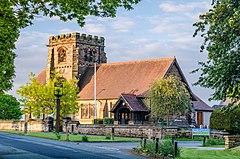Appleton Thorn
| Appleton Thorn | |
|---|---|
 St. Cross Church, Appleton Thorn |
|
| Appleton Thorn shown within Cheshire | |
| Population | 10,477 (2001) |
| OS grid reference | SJ640839 |
| Civil parish | |
| Unitary authority | |
| Ceremonial county | |
| Region | |
| Country | England |
| Sovereign state | United Kingdom |
| Post town | WARRINGTON |
| Postcode district | WA4 |
| Dialling code | 01925 |
| Police | Cheshire |
| Fire | Cheshire |
| Ambulance | North West |
| EU Parliament | North West England |
| UK Parliament | |
Appleton Thorn is a village in the borough of Warrington in Cheshire, England.
Appleton appeared in the Domesday survey as Epeltune, meaning "the tun where the apples grew".
Each June, the village hosts the ceremony of "Bawming the Thorn". The current form of the ceremony dates from the 19th century, when it was part of the village's "walking day". It involved children from Appleton Thorn Primary School walking through the village and holding sports and games at the school. This now takes place at the village hall. The ceremony stopped in the 1930s, but was revived by the then headmaster, Mr Bob Jones in the early 1970s. "Bawming the Thorn" occurs on the Saturday nearest to Midsummer's Day.
Local schoolchildren dance around the tree in the style of a maypole chanting verses to the tune of Bonnie Dundee, with the following repeated chorus:
Up with fresh garlands this midsummer morn,
Up with red ribbons on Appleton Thorn.
Come lasses and lads to the Thorn Tree today
To bawm it and shout as yet bawm it "Hurray"!
Bawming means "decorating" – during the ceremony the thorn tree is decorated with ribbons and garlands. According to legend, the hawthorn at Appleton Thorn grew from a cutting of the Holy Thorn at Glastonbury, which was itself said to have sprung from the staff of Joseph of Arimathea, the man who arranged for Jesus's burial after the crucifixion.
Thorn Cross (HM Prison) is in Appleton Thorn, on the site formerly occupied by Royal Naval Air Station HMS Blackcap, a wartime aircrew training and aircraft repair airfield. There are a number of graves of aircrew who died at HMS Blackcap, mainly in flying accidents, in St Cross churchyard, known locally as "the war graves".
Notes
Bibliography
...
Wikipedia

